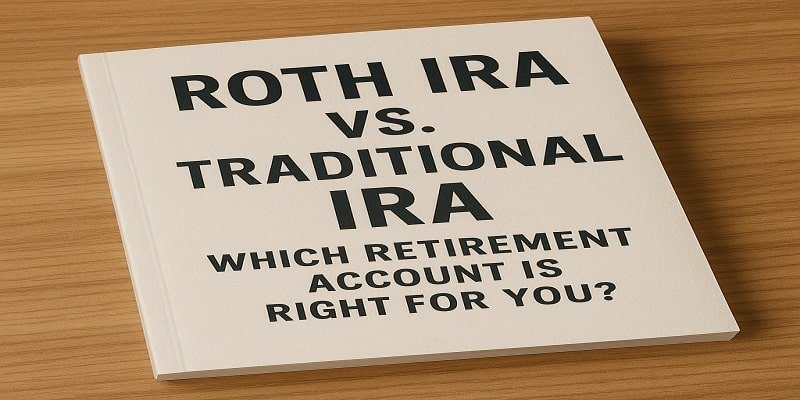“Roth IRA vs Traditional IRA”
Roth IRA vs Traditional IRA: Planning for retirement can seem daunting, especially when you’re faced with options like the Roth IRA vs. the traditional IRA. Both are great tax-advantaged accounts, but they work very differently. Understanding the key differences will help you decide which one is best suited for your financial goals.
In this guide, we’ll explain the Roth IRA vs. traditional IRA debate in simple terms, including contribution rules, tax benefits, withdrawals, and more. By the end, you’ll know which IRA is the better choice for your future.
What is an IRA?
An IRA (Individual Retirement Account) is a savings account designed to help you accumulate money for retirement while enjoying tax benefits. There are two main types:
1. Traditional IRA – Offers a tax deduction now, but you have to pay taxes on withdrawals later.
2. Roth IRA – No upfront tax breaks, but withdrawals in retirement are tax-free.
Both accounts have annual contribution limits ($7,000 in 2024, or $8,000 for those age 50+), but their tax regimes are opposite. Let’s take a deeper look at the Roth IRA vs Traditional IRA comparison.
Key Differences Between Roth IRA and Traditional IRA
1. Tax regime: Pay now or later?
The biggest difference between a Roth IRA and a traditional IRA is when you pay taxes.
Traditional IRA:
- Tax-deductible contributions – If eligible, you can deduct contributions from your taxable income now, reducing your current tax bill.
- Tax-deferred growth – Investments grow tax-free until retirement.
- Taxable withdrawals – In retirement, every dollar you withdraw is taxed as ordinary income.
Roth IRA:
- No upfront tax break – You contribute after-tax amounts (no deductions now).
- Tax-free growth – Investments grow without taxes in the future.
- Tax-free withdrawals – After age 59½, all qualified withdrawals (contributions + earnings) are tax-free.
Which is better? If you expect to be in a higher tax bracket in retirement, a Roth IRA may make you save more in the long run. If you want immediate tax relief and expect lower taxes later, a traditional IRA may be better.
2. Income limits: Can you even contribute?
Not everyone can contribute to a Roth IRA or traditional IRA – there are income limits.
Roth IRA income limits:
- Single filers: Full contributions allowed if MAGI < $146,000; phased out to $161,000.
- Married individuals filing jointly: Full contributions if MAGI is less than $230,000; phased out up to $240,000.
- Traditional IRA deduction limits:
- If you (or your spouse) have a workplace retirement plan (such as a 401k), your ability to deduct contributions phases out when you have a higher income.
- Single filers with a workplace plan: Full deduction if MAGI is less than $77,000 (phased out up to $87,000).
- Married individuals filing jointly: Full deduction if MAGI is less than $123,000 (phased out up to $143,000).
The bottom line: High-income individuals may be denied Roth IRA contributions (although a “backdoor Roth IRA” is an option). There are no strict income limits for contributions to a traditional IRA, but deductions may be limited.
3. Required Minimum Distributions (RMDs)
Another big difference in contention between a Roth IRA and a traditional IRA is forced withdrawals.
- Traditional IRA:
- You must begin taking required minimum distributions (RMDs) at age 73 (until 2024).
- These withdrawals are taxed as income, whether you need the money or not.
- Roth IRA:
- No RMDs during your lifetime – you can let the money grow tax-free forever.
- Heirs are required to take RMDs, but they are still tax-free if the account has been open for at least 5 years.
Why it matters: If you don’t want to be forced to withdraw money, a Roth IRA offers you more flexibility.
4. Early Withdrawal Rules
Do you have to take money out of your IRA before retirement? The rules for Roth IRAs and traditional IRAs differ here, too.
- Traditional IRA:
- Withdrawals before age 59½ incur a 10% penalty, plus income taxes (with some exceptions, like buying a first-time home or medical expenses).
- Roth IRA:
- You can withdraw contributions (not earnings) at any time, tax-free and penalty-free.
- Earnings withdrawn before age 59½ may be subject to taxes and penalties, unless an exception applies.
The bottom line: A Roth IRA is more flexible if you need early access to your contributions.
Roth IRA vs Traditional IRA: Which One Should You Choose?
Still unsure? Here’s a quick cheat sheet:
Choose a Roth IRA if you… ✅ Expect to be in a higher tax bracket in retirement.
✅ Want tax-free withdrawals later.
✅ Like the idea of no RMDs.
✅ Are young (you have decades for tax-free growth).
Choose a traditional IRA if you…
✅ Want an immediate tax cut.
✅ Expect to be in a lower tax bracket in retirement.
✅ Don’t mind RMDs.
✅ Are a high-income individual who can’t contribute directly to a Roth IRA.
Can you do both?
Yes! You can contribute to both a Roth IRA and a traditional IRA in the same year, provided your total contributions don’t exceed the annual limits ($7,000 or $8,000 if 50+).
Final Thoughts on Roth IRA vs Traditional IRA
The decision between a Roth IRA and vs. Traditional IRA depends on your current tax situation, future expectations, and retirement goals.
- Roth IRA = Pay taxes now, enjoy tax-free money later.
- Traditional IRA = Get a tax break now, pay taxes later.
If you’re still unsure, consider splitting contributions between the two or consulting a financial advisor. The most important thing? Start saving early—whether in a Roth IRA or a traditional IRA—so your future self can retire comfortably.
A Recap of the Key Differences
| Feature | Roth IRA | Traditional IRA |
|---|---|---|
| Tax Break | No (after-tax contributions) | Yes (deductible now) |
| Withdrawals | Tax-free in retirement | Taxed as income |
| RMDs | None during your lifetime | Start at age 73 |
| Income Limits | Yes (high earners may be excluded) | Dedication phase-out at higher incomes |
| Early Withdrawals | Contributions accessible anytime | Dedication phase out at higher incomes |
Now that you understand the differences between a Roth IRA and a traditional IRA, which one will you choose for your retirement savings?
FAQs about Roth IRA vs Traditional IRA
1. Can I contribute to both a Roth IRA and a traditional IRA in the same year?
Yes! You can contribute to both a Roth IRA and a traditional IRA in the same year, but your total contributions cannot exceed the annual limit ($7,000 in 2024, or $8,000 if you’re age 50+). However, tax benefits will apply based on the rules of each account—a deduction (if eligible) for a traditional IRA and tax-free growth for a Roth IRA.
2. Which IRA is better if I expect to earn more in retirement?
If you think your tax bracket will be higher in retirement, a Roth IRA is usually the better choice. Since you pay taxes upfront, your withdrawals (including earnings) will be completely tax-free in retirement. With a traditional IRA, you’ll have to pay taxes later, potentially at a higher rate.
3. Are there any penalties for early withdrawals?
- Traditional IRA: Withdrawals before age 59½ typically incur a 10% penalty and income taxes (with some exceptions, such as buying a first home or medical expenses).
- Roth IRA: You can withdraw your contributions (not earnings) anytime, tax and penalty-free. Earnings withdrawn prematurely may incur taxes and penalties, unless an exception applies.
4. What if I exceed the income limits for a Roth IRA?
If your income is too high for a straight Roth IRA contribution, you can use a backdoor Roth IRA strategy:
1. Contribute to a traditional IRA (no income limits).
2. Convert it to a Roth IRA (you’ll only have to pay taxes on pre-tax income).
This exemption allows higher earners to legally access Roth IRA benefits.
5. Do I have to withdraw money from my IRA in old age?
- Traditional IRA: Yes! You must begin taking required minimum distributions (RMDs) at age 73 (by 2024), and these withdrawals will be taxed as income.
- Roth IRA: No RMDs during your lifetime—you can let the money grow tax-free forever (RMD rules for beneficiaries will apply).
Final Tips
Still unsure? Consider your current tax rate vs. expected future rate, flexibility needs, and long-term goals when choosing between a Roth IRA and a traditional IRA. If in doubt, a mix of the two can provide tax diversification in retirement!


